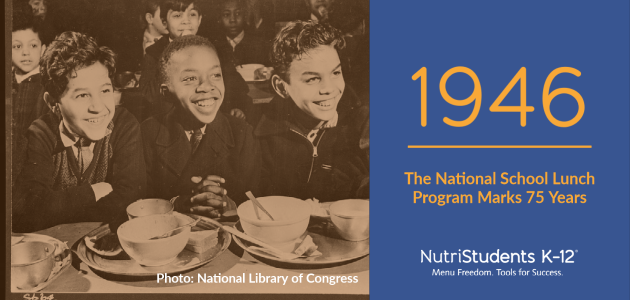
We’re all pretty familiar with the National School Lunch Program as it is today. Who among us has ever dug into its history though? In honor of the program’s 75th anniversary on June 4, we explore its past.
Its early history is rooted in the cities of Philadelphia and Boston. In Philadelphia, welfare organizations began serving penny lunches to high school students in 1894. Meanwhile, in Boston, home economics classes started a program serving milk and sandwiches to elementary school students three days a week. Programs like these began to sprout up throughout the country in the early part of the 20th century, yet not without challenges–schools did not have kitchens or equipment to prepare food, or even dedicated dining spaces for students.
It wasn’t until the Great Depression that the federal government became involved. In the 1930s, school meal programs emerged as a perfect solution to numerous challenges: collapsing crop prices, unemployment, and increasing child malnutrition and hunger. As part of President Franklin Roosevelt’s New Deal, the federal government purchased surplus crops and employed thousands to cook and serve meals to students across the United States.
Unfortunately, this program wasn’t permanent. As food supplies dwindled and labor became scarce during World War II, the number of school meals served declined rapidly. Thankfully, claims that many American men had been rejected for military service due to diet-related health problems fueled the drive for legislation to improve child nutrition.
On June 4, 1946, President Harry S. Truman signed into law the National School Lunch Act, declaring it "to be the policy of Congress, as a measure of national security, to safeguard the health and well-being of the Nation’s children." This law was the foundation of the NSLP, providing the means to support the infrastructure of school kitchens and cafeterias, as well as giving schools financial support and agricultural commodities to ensure healthy, low or no-cost meals to students.
The breadth and impact of the NSLP over the span of time is impressive. About 7.1 million children participated in the first year of the program. In the most recent figures provided by the USDA, more than 30 million children nationwide benefit from this program each year. The benefits are impressive, too. Multiple studies show the program continues to play a significant role in preventing obesity and contributing to overall student health by providing more nutritious meals to students while combatting food insecurity. These past 75 years have impacted a lot of lives, and we are look forward to continuing to contribute and support child nutrition programs for continued success in the future!